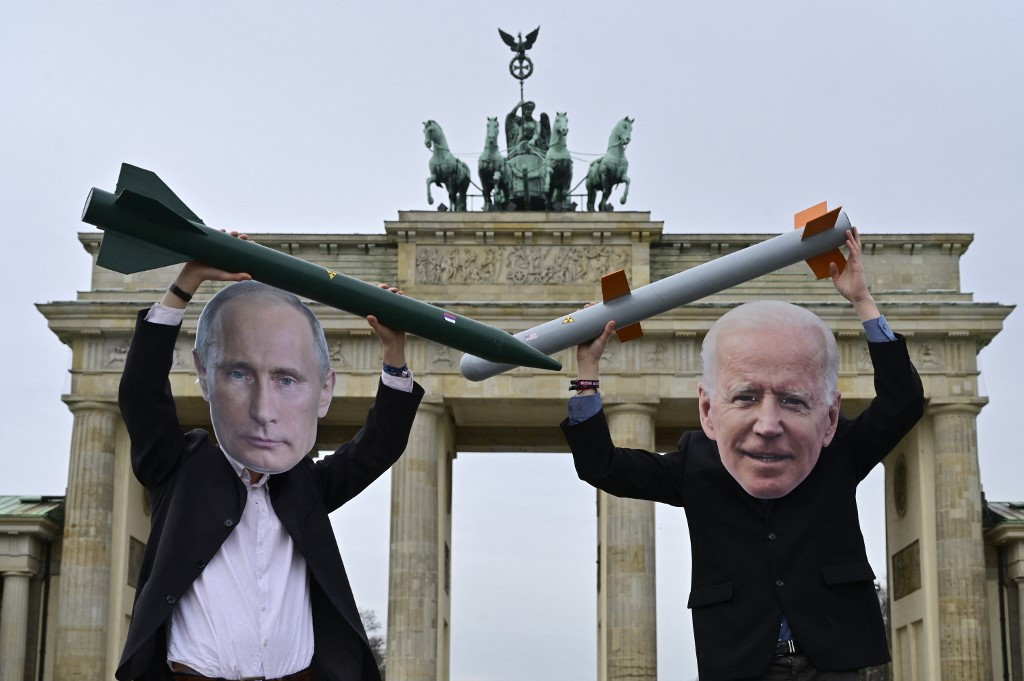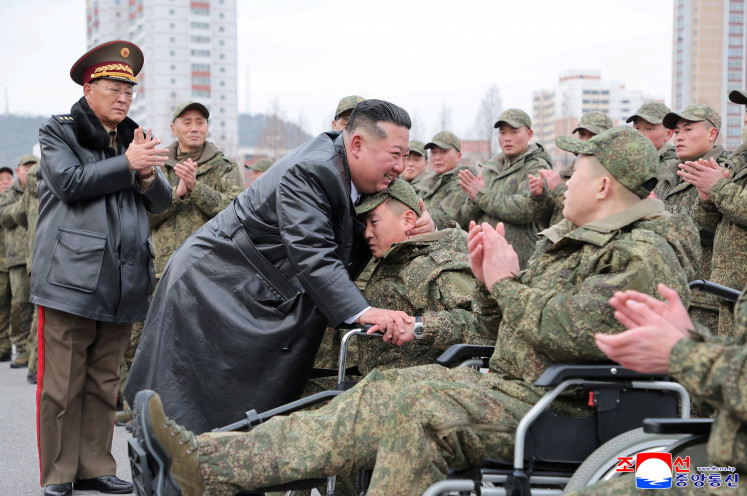Popular Reads
Top Results
Can't find what you're looking for?
View all search resultsPopular Reads
Top Results
Can't find what you're looking for?
View all search resultsNuclear sabre-rattling: other times when war threatened
In October 1962, at the heart of the Cold War, a 13-day showdown between Soviet leader Nikita Khrushchev and US president John F. Kennedy leads to fears of nuclear war.
Change text size
Gift Premium Articles
to Anyone
 Peace activists wearing masks of Russian President Vladimir Putin (left) and newly elected US President Joe Biden pose with mock nuclear missiles in front of Berlin's landmark the Brandenburg Gate on January 29, 2021 in an action to call for more progress in nuclear disarmament. The Russian parliament on January 27, 2021 unanimously voted to ratify an agreement to extend by five years a key nuclear pact with the United States that was set to expire soon. Signed in 2010, the New START contract caps to 1,550 the number of nuclear warheads that can be deployed by Moscow and Washington, which control the world's largest nuclear arsenals. The agreement, which was due to expire on February 5, is seen as a rare opportunity for compromise between Moscow and Washington, whose ties have dramatically deteriorated in recent years. (AFP/John Macdougall)
Peace activists wearing masks of Russian President Vladimir Putin (left) and newly elected US President Joe Biden pose with mock nuclear missiles in front of Berlin's landmark the Brandenburg Gate on January 29, 2021 in an action to call for more progress in nuclear disarmament. The Russian parliament on January 27, 2021 unanimously voted to ratify an agreement to extend by five years a key nuclear pact with the United States that was set to expire soon. Signed in 2010, the New START contract caps to 1,550 the number of nuclear warheads that can be deployed by Moscow and Washington, which control the world's largest nuclear arsenals. The agreement, which was due to expire on February 5, is seen as a rare opportunity for compromise between Moscow and Washington, whose ties have dramatically deteriorated in recent years. (AFP/John Macdougall)
W
ith President Vladimir Putin putting Russia's vast nuclear arsenal -- the world's largest -- on alert, we look back on other moments the threat of atomic war loomed.
1962: Cuban missile crisis
In October 1962, at the heart of the Cold War, a 13-day showdown between Soviet leader Nikita Khrushchev and US president John F. Kennedy leads to fears of nuclear war.
On October 14, US reconnaissance aircraft photograph Soviet intermediate-range missile launch pads on Cuba, just 145 kilometres (90 miles) from the US.
Unwilling to allow the Soviets to position their nuclear arsenal so close to the US, Kennedy warns Khrushchev he will attack the Soviet Union if it does not withdraw the missiles, and orders a naval blockade of Cuba, mobilising 140,000 troops.
Khrushchev agrees to withdraw the missiles in return for Washington promising not to invade Cuba and taking its Jupiter missiles out of Turkey.
2001-2002: India-Pakistan nuclear crisis
In May 2002, India and Pakistan, at odds over the disputed Himalayan state of Kashmir since their partition in 1947, go to the brink.
India blames Islamists from Pakistan for a suicide attack against the parliament in New Delhi on December 13, 2001, which left 14 dead.
The two countries, which became nuclear powers in 1998, mobilise a million soldiers on the border.
In April 2002, Pakistani president Pervez Musharraf says he would use nuclear weapons if threatened with destruction by an attack from India.
India's defence minister George Fernandes says "India can survive a nuclear attack, but Pakistan cannot."
For the next two years New Delhi and Islamabad carry out tit-for-tat missile tests, but there is then a de-escalation under pressure from Washington.
A ceasefire in November 2003 is followed by dialogue in January 2004.
Hiroshima and Nagasaki
The US is the only country to have used nuclear weapons. The attacks on Hiroshima and Nagasaki in 1945 killed 214,000 people and led to the surrender of Japan and the end of World War II.









